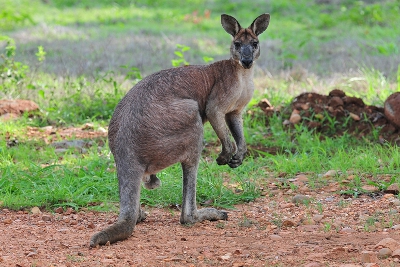Wallaroo
Category: Marsupial

Facts about Wallaroo (Macropus robustus) The name wallaroo is derived from Wallaby and kangaroo. It is an Australian marsupial that has a body size which is between that of wallaby and kangaroo. They are four different types of wallaroos within Australia depending on the region. We have the Euro, eastern Wallaroo, Antilopine Wallaroo and Black Wallaroo. The Antilopine Wallaroo looks more like a kangaroo in its lifestyle as opposed to the other types of wallaroos. It stays in groups rather than a solitary state.
Physical Description of Wallaroo
The Eastern and the Euro Wallaroos have coats of gray fur and reddish fur respectively. They have big ears and a bare black nose. The males usually grow to between 3 feet 3 in to 4 feet 6 inches (1 and 1.4 meters) in height. In terms of weight, they range from 99 to 48.5 pounds ( 45 to 22 kilograms). The female wallaroo is comparably smaller with a height measuring between 2 feet 4 inches 3 feet 3 inches (0.75 and 1 meter) while their weight averages between 39.7 to 49.6 pounds (18 and 22.5 kilograms).
Habitat and Feeding of Wallaroo
Wallaroos can be spotted in rocky areas where they hide mostly during the day and only come out at night to eat small shrubs and grass. Their feet are well adapted with fur on the pads to help them scale the rocks.
Reproduction of Wallaroo
The wallaroo attain sexual maturity at between 18 and 24 months old. They breed the whole year as opposed to specific seasons. After 32 days of gestation, their baby (joey) is born measuring the size of a peanut. Joey is born without fur and they are usually blind but somehow find their way into their mothers pouch. They stay in the pouch for 9 months in order to attain complete maturity. Wallaroos can still get pregnant when the baby is still in the pouch. They live for a period of between 17 and 18 years.
Adaptation of Wallaroo
During drought, wallaroos dig holes in the ground of up to (1 meter) in an attempt to find water. Just like camels, these marsupials lose only about 2 to 4% of their body weight per day. This makes the Wallaroo survive the dry season until they can find food and water again.

 Back To Category Marsupial
Back To Category Marsupial